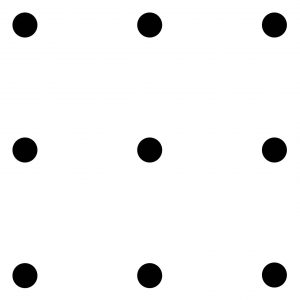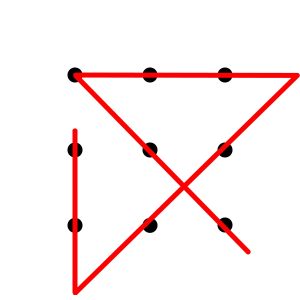Ideology
Nicholas David Gerstner
Nicholas Gerstner is a doctoral student in the Department of Communication at the University of North Carolina at Chapel Hill. As a media and cultural studies scholar, his work explores the construction of “polarization” in the contemporary conjuncture.
Thinking With(in) the Box: The nine dot puzzle
Try to complete the puzzle below.
Using a pencil, connect the nine dots with four straight lines. Do not lift your pencil from the paper while doing so.

First published in Samuel Loyd’s 1914 Cyclopedia of Puzzles, the nine dot problem still challenges even the smartest thinkers today. This small puzzle has had an outsized cultural impact: in the 1970s and 1980s it was used to train corporate employees—most famously those at Disney—in creative thinking, and today there is a $100,000 “Nine Dots Prize” for innovative approaches to contemporary problems.
Did you solve the puzzle? Here’s a hint: doing so requires literally “thinking outside the box.” Sound familiar? This puzzle is the source of that now-cliché phrase.

Once explained, the solution may appear obvious. After all, the instructions say nothing about staying within a box, square, or boundary. So, what makes this puzzle so difficult? Why is “thinking inside the box” so ingrained? Where does “box thinking” come from, and what work does it do?
Ideology can help explain why the nine dot puzzle is so difficult. Generally, theories of ideology insist that our ideas—from opinions on presidential candidates and Netflix programming to family structures, personal habits, and puzzle-solving practices—are shaped by our shared social and material worlds. While the exact nature of the relationships between material things—Big Macs, smartphones, tractors—and ideas—politics, art, religion—are highly debated, theorists often agree that the question of how and what we think in a specific period and place can be answered by exploring the social and material things that we use to survive and thrive.
Work on ideology is closely linked to theories of identity, culture, and power. Frequently cited examples include capitalism, socialism, communism, (neo)liberalism, conservatism, and fundamentalism. These ideologies often mix and are further complicated by ideologies of race, gender, ability, and ethnicity. Ideologies are complex, contradictory, and varied.
To understand “box thinking,” a theory of ideology might direct our attention to how we learn, work, and play. From the moment we start school, we are taught to think inside the box: coloring books ask us to draw within the lines of the image, and written assignments occur on blue-lined notebook paper. School cafeterias, airports, and banks demand that we stand in lines, and refusing to do so risks punishment. Moving outside the box or across the line while travelling is quite dangerous: painted lines on roads prevent car crashes as the concrete squares of the sidewalk direct those on foot. Smartphones, televisions, tablets, and computer monitors direct attention to bounded rectangles for much of our time awake.
For most people, the lines, rectangles, and squares that surround us become habitual or subconscious tools to think with. And as they become habitual, ideologies—“box thinking” in this case—start to appear natural and obvious. For those who think with a particular ideology, it is hard to think differently. “Thinking outside the box” is only difficult in a society in which thinking inside the box is the norm.
Discussion Questions
- What ideologies are at work in your life? Keep in mind that living with an ideology is not the same as agreeing with it, and that ideologies often appear natural and obvious. How do these ideologies shape you and your community?
- Is “box thinking” an ideology in the same way that liberalism, capitalism, or patriarchy are? How is it similar or different?
- Choose one ideology, and briefly describe its core ideas. How are those ideas related to your social and material world?
Additional Resources
Althusser, L. (1971). Ideology and ideological state apparatuses: Notes towards an investigation. In Lenin and philosophy and other essays. New York: Monthly Review Press.
Eagleton, T. (1994/2013). Ideology. London: Routledge.
Hall, S. (2003). Marx’s notes on method: A ‘reading’ of the ‘1857 introduction’. Cultural Studies 17(2), 113-149.
Loyd, S. (1914). Cyclopedia of Puzzles. Retrieved from http://cyclopediaofpuzzles.com/
Vance, M. and Deacon, D. (1995). Think out of the box. Franklin Lakes: Career Press.
Williams, R. (1976). Ideology. In Keywords: A vocabulary of culture and society. New York: Oxford University Press, 126-130.

